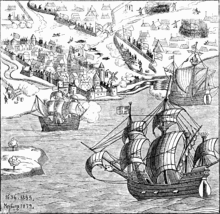Count feud
The Danish Count Fejde ( Danish : Grevens fejde ) was a civil war in Denmark that lasted between 1534 and 1536 and takes its name from the Counts Christoph von Oldenburg and Johann von Hoya involved .
prehistory
In 1523 the Danish King Christian II was deposed by his uncle Friedrich I. Sweden achieved independence under King Gustav Vasa with the support of Lübeck. In 1532 Christian II tried to recapture Norway and, again with the help of the Lübeck fleet, was finally defeated and imprisoned in Sønderborg Castle . Lübeck received extensive privileges in Denmark as a reward.
When Friedrich I died in 1533, the Danish Imperial Council could not agree on a successor. The Catholic aristocrats feared that their power would be curtailed by Friedrich's eldest son, Duke Christian (later King Christian III), who was inclined to the Reformation . The younger son Johann had grown up under their influence, but not yet of legal age. The election of the king was therefore postponed for a year.
The Lübeck council under its mayor Jürgen Wullenwever offered its support to Duke Christian, who previously only ruled the Hadersleben office in the north of the Duchy of Schleswig , in the hope of extending the trade advantages. The duke refused to free the lands under the Danish crown from the trading supremacy of the Hanseatic League . In this situation, Oldenburg Count Christoph asked Lübeck for help in the war to free his captive cousin Christian II. Gustav Vasa's brother-in-law Johann von Hoya and the Protestant cities of Copenhagen and Malmö under the mayors Ambrosius Bogbinder and Jörgen Kock also took part in the battles against the still catholic danish nobility.
Denmark without a king in distress
In the spring of 1534 the war broke out. Without a declaration of war , the Lübeck general Marx Meyer invaded Holstein and devastated Trittau , Reinbek , Eutin and, after an unsuccessful siege of the Siegesburg, the city of Segeberg and some mansions of the Rantzau family . At the same time, Count Christoph quickly conquered Zealand and Funen . In this way, rule over the sound was achieved and Lübeck was able to claim the sound tariff for itself. At the same time, the Jutian farmers rose under the skipper Clement .
In view of the apparently effortless victory, the Hanseatic cities of Stralsund , Rostock and Wismar as well as the Dithmarsch farmers and the Mecklenburg Duke Albrecht VII joined the alliance against the Danish king. In order to gain further support, Wullenwever offered the Danish crown not only to the Earl of Oldenburg, but also to the English king and the Elector of Saxony . The Mecklenburg duke, who had hoped for Denmark, was promised the Swedish crown, because Wullenwever now intended to overthrow Gustav Vasa, who in his eyes was ungrateful. This led to controversy and a lack of cooperation among the allies. The princes also did not send enough troops for a long time and paid them so poorly that morale fell after the initial successes.
Turn in favor of Denmark
Only in this distressed situation - almost all of Denmark was in the hands of the enemy - the Imperial Council appointed the Duke King Christian III on August 10, 1534. - and actually lost much of its influence for it. The tide turned: after the Peace of Stockelsdorf ended the war in Holstein in November 1534, the Danes, now united under one king, strengthened themselves against the attackers who had quarreled among themselves. Christian III received support. by Gustav Vasa and his brother-in-law, the Prussian Duke Albrecht of Brandenburg-Ansbach .
After the peasant uprising was put down and Count Christoph's defeat on Funen against Johann Rantzau, the Lübeck fleet was finally defeated in the sea battles near Bornholm and Svendborg in June 1535 against a united Danish-Swedish-Prussian fleet under the Danish admiral Peder Skram .
Lübeck surrendered in July. The Hanseatic League was decisively weakened politically by the defeat of Lübeck. The old Lübeck council returned. Wullenwever, who had been deposed in Lübeck in August 1535, tried to continue the war on his own. In November 1535 he was arrested south of Hamburg while trying to recruit support troops for besieged Copenhagen and executed in 1537. Marx Meyer held out in the besieged Varberg fortress until May 1536 .
The feud of counts ended on August 6, 1536 with the capitulation of Copenhagen after a year-long siege.
literature
- Friedrich von Alten: Count Christoff von Oldenburg and the count feud (1534–1536) . Perthes-Besser & Mauke, Hamburg 1853 ( digitized version ).
- Matthias Asche, Anton Schindling: Denmark, Norway and Sweden in the age of the Reformation and confessionalization . Aschendorff Verlag, 2002, ISBN 3-402-02983-9 .
Web links
See also: List of Wars , List of Battles
